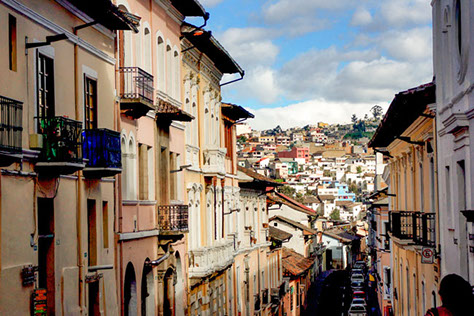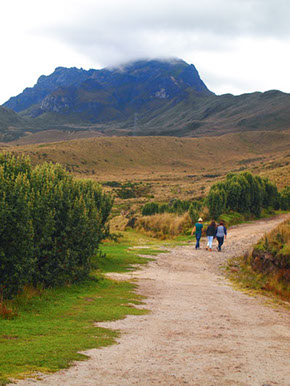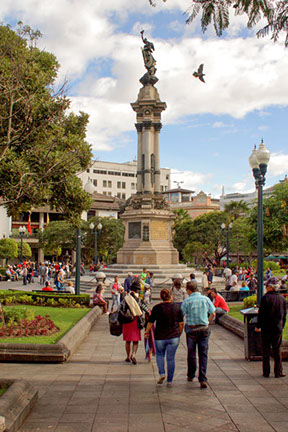

Ceviche for Breakfast
The expansive breakfast buffet at Quito’s luxurious Colón Hilton Hotel has something for every taste, from the cold cuts, hard boiled eggs and cheese favored by many Europeans, to the more conventional fare I’d loaded on my plate – slices of papaya, mango and watermelon, a mound of scrambled eggs, and an arepa. My tablemates, though, a trio of music journalists from Buenos Aires, Guadalajara and Los Angeles attending the annual Ecuador Jazz festival, were clearly marching to their own distinctive culinary drumbeat. With a mixture of curiosity and bemusement, I asked the obvious: “Ceviche for breakfast?” Humphrey, a critic for Argentina’s major daily newspaper, La Nación, happily responded, “Why not?” His goatee-accented face broke into a broad smile as he sampled another forkful of the hotel’s signature seafood delight. “This is some of the best I’ve ever had. Got to take advantage of it!”
While having ceviche for breakfast might not top the must-do list for the majority of Quito-bound visitors, it serves as a reminder: be prepared to experience the unexpected when Ecuador’s enchanting capital city is your destination. The greater metropolitan area, home to slightly less than three million souls, is accented by verdant parks and historic plazas, a hilly landscape that lends drama to the city’s mélange of ultramodern high-rises and colonial-era landmarks, and a skyline dominated by a half dozen surrounding volcanos. Most visitors, in a hurry to get to the Ecuadorian Amazon, the Galapagos Islands and other well-known tourist attractions, will spend but a day or two in Quito before they rush off. Time to buy an authentic Panama hat, squeeze in a quick city tour, and visit La Mitad del Mundo, a popular site 20 miles from Quito where visitors can pose for selfies with one foot in the northern hemisphere, the other south of the equator. Many easygoing charms of this culturally-dynamic destination, however, will remain largely undiscovered by most casual visitors.
A great place to begin – or end – a Quito visit is the Casa de la Cultura Ecuatoriana, a museum that documents the country’s complex and endlessly fascinating national traditions through the visual arts and collections of rare artifacts, including music instruments that evolved over the centuries in concert halls and jungle villages. You might catch sight of a noted painter, Manuel F. García, and a small crew of white-jacketed associates at work in a brightly-lit corner of the facility, undertaking painstakingly restoration work on some of the country’s most treasured paintings. Trained in Italy for this exacting and technically-demanding task, García is happy to pause to explain the significance of his project. “How many are fortunate enough to be able to hold their country’s history in their hands,” he asks rhetorically. “I’m a lucky guy.”
Quito’s mountain air, at 9,350 feet above sea level, is crisp and clean and makes savoring a good cup of coffee all the more pleasurable. Suvlaki, a sparkling new Greek restaurant on Avenida Amazonas, a centrally-located street that’s lined with trendy cafes and shops specializing in locally-produced textiles, ceramics, artwork and books, is a great place to get a morning caffeine fix. Adriana Moreno and her husband Gregorio, both natives of Ecuador, met while working at a resort in Greece and developed a love of traditional Greek cuisine. They returned to Quito to introduce locals to their favorite dishes from the eastern Mediterranean and now operate two popular restaurants.
Between taking orders and counting out change (Ecuador, by-the-way, uses the U.S. dollar as its official currency), Adriana gestures toward her restaurant’s canopy-covered, sidewalk-fronting outdoor dining area. A group of nattily-dressed elderly men sipping coffee and chatting has become part of the avenue’s daily social scene. “They’ve been meeting over coffee for about 30 years,” she comments. “For more than two decades, they went to another cafeteria up the avenue. When we opened a few years ago, we worked hard to attract them. It was tough trying to get their patronage, but we did it! Now they are loyal to us!”
Adriana also sees her fair share of foreign visitors and is quick to offer them an insider’s advice on where to go and what to see. “The historic center,” she notes, “is especially nice at night. There is a very creative use of lighting to illuminate the area’s principal attractions.” Indeed, regardless of the time of day, this architecturally distinctive region lays claim to being the largest and best preserved historic districts of any city in Latin America. The Plaza de la Independencia, the city’s most important public square, is home to the seats of national and municipal governments and the Catholic hierarchy.
In-the-know visitors will want a ringside seat for the weekly changing of the guard at the presidential palace every Monday at 11 a.m. A military band and soldiers on horseback carrying flag-tipped lances create a colorful, tradition-bound scene right out of a Hollywood costume opera. Watch for the president to appear on the balcony, waving to his supporters. A few blocks away, the more serene Plaza del Teatro offers another inviting gathering point. The imposing Sucre National Theater, a recently-restored French-style opera house that was constructed in the 1880s, stages regular attractions that range from Broadway musicals to concerts by jazz and classical artists and symphony orchestras.
It’s not surprising that many of Adriana’s suggestions involve where to go to catch the best views of Quito, which can be stunning from any angle and at any hour of the day or night. “I love Itchimbía Park,” she says. “If you go at 5 p.m. the view is quite lovely.” The park offers one of the best ways to take in an arresting, birds-eye perspective of the massive Basílica del Voto Nacional, a neo-Gothic cathedral that is the largest edifice of its design in the Western Hemisphere. She is also fond of Hacienda Rumiloma, a highly regarded hotel and restaurant that’s perched high above the city at the gateway to the Pichincha National Park, the still-active volcano that hovers over central Quito.
The teleférico which transports visitors up the Pichincha volcano in ski resort-style gondolas, is truly a not-to-be-missed adventure. Just 10-minutes by taxi from most hotels, the cable car line provides a 20 minute ride up the steep mountainside, often shrouded in low-laying clouds. For those who want even more dramatic views, a system of trails beckons, extending all the way to the summit. At sunset, the vista provides a stunning reminder of just how special a visit to Quito can be.
By Mark Holston

